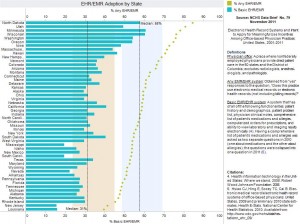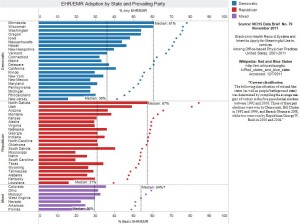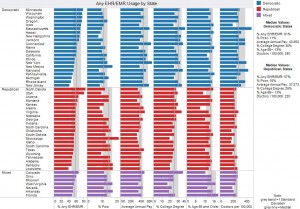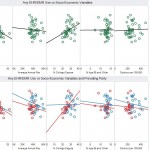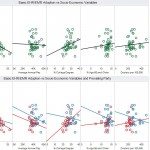According to recent estimates by the CDC, the use of electronic health and medical records in physician offices continues to climb. According to data from the November 2011 NCHS Data Brief, around 57 percent of office based physicians report using some kind of electronic health/medical record system and around 34 percent report having a system that meets basic performance criteria. However, EHR/EMR usage varies widely by state, as can be seen in the graph below.
The graph shows states in descending order based on the usage of any type EHR/EMR system. The series of dots illustrates usage of any system, while the bars illustrate usage of systems that meet basic criteria. Median percentages are illustrated by dotted lines. Colored shading indicates the percentage range into which most (68%) states fall. The shaded area on the left applies to usage of basic systems, the shaded area to the right applies to usage of any EHR/EMR system.
As we can see from the jagged outline of the blue bars, adoption of systems that meet basic performance criteria is not necessarily consistent with overall usage of electronic record systems. For example, Utah ranks number 2 in terms of overall EHR/EMR usage, but four states rank higher than Utah in terms of systems with basic functionality. These four states are Minnesota, Wisconsin, Washington and Oregon.
North Dakota, Utah, Minnesota, Wisconsin, Washington, Oregon and Hawaii not only lead the nation in terms of overall EHR/EMR usage, but also in terms of having basic systems in place. Looking toward the lower end of the list, we can see that states like Mississippi, South Carolina, Nevada, New Jersey and Louisiana have the lowest percentages of systems that meet basic criteria.
Given the current state of the debate around health care reform, one might be tempted to ask whether the political climate at the state level plays a role. Using information about “Red States and Blue States” from Wikipedia, we can assign party affiliations to states based on results from the past five presidential elections (1992 to 2008). At first glance, it appears that democratic states tend to be further along in terms of EHR/EMR system usage. Their median percentages for overall usage (61%) and basic system usage (36%) are higher than those of republican states (57% and 31% respectively).
However, reducing this question to simple partisan politics ignores the many factors influencing the adoption of complex systems. Issues like perceptions and attitudes, computer experience, workflow impact and concerns about patient-doctor relationships play a much bigger role in the day to day decisions doctors make. These issues are beyond the scope of this writing, though a very small sampling of relevant academic research appears at the end of this post.
Even without delving into those issues, we can get a sense that there is more at play here by looking at socio-economic data from the US Census Bureau. The graph below shows the usage of any type of EHR/EMR system, along with census data about poverty, annual pay, higher education, age, and number of physicians per capita.
Using this graph, we notice that our breakout of Democratic and Republican states shows some significant differences. The thick grey lines indicate the median value for each variable within each party category, while the grey shading shows the range into which the majority (68%) of states in each category fall. Based on this data, residents in democratic states tend to be
- wealthier (lower percentage of people living below the poverty line)
- earn higher incomes (higher average annual pay)
- more educated (higher percentage of residents with a bachelor degree or higher)
- able to choose among more doctors (higher rate of doctors per capita)
Since we are dealing with state level data we cannot say how much each of these factors influence EHR/EMR system adoption (see scatter plots at the end), except to say that higher levels of poverty appear to be linked to lower levels of EHR/EMR system usage – apparently more so if the state happens to lean republican.
Unfortunately this exploration suffers from the fact that we are dealing with high level data which hinders our ability to match up relevant details. None the less, it provides some hints that socio-economic issues play at least an indirect role in the adoption and use of EHR/EMR systems.
Resources:
Explore the data details behind the graphs in this post via this interactive Tableau Workbook.
Electronic Health Record Systems and Intent to Apply for Meaningful Use Incentives Among Office-based Physician Practices: United States, 2001–2011
NCHS Data Brief, Number 79, November 2011
http://www.cdc.gov/nchs/data/databriefs/db79.htm
Definitions used in this report (direct quote from the NCHS Data Brief):
“Physician office: A place where nonfederally employed physicians provide direct patient care in the 50 states and the District of Columbia; excludes radiologists, anesthesiologists, and pathologists.
Any EMR/EHR system: Obtained from “yes” responses to the question, “Does this practice use electronic medical records or electronic health records (not including billing records)?”
Basic EMR/EHR system: A system that has of all of the following functionalities: patient history and demographics, patient problem list, physician clinical notes, comprehensive list of patient’s medications and allergies, computerized orders for prescriptions, and ability to view laboratory and imaging results electronically (4). Having a comprehensive list of patient’s medications and allergies was asked as two separate questions in 2010 (one about medications and the other about allergies); the questions were collapsed into one question in 2011 (5).”
The 2012 Statistical Abstract: State Rankings
U.S. Census Bureau
http://www.census.gov/compendia/statab/rankings.html
Red states and blue states
http://en.wikipedia.org/wiki/Red_states_and_blue_states
Direct quote from the wiki article:
“Current classification
The following classification of red and blue states (as well as purple/battleground states) was determined by compiling the average margins of victory in the five presidential elections between 1992 and 2008. Three of these past elections were won by Democrats, Bill Clinton in 1992 and 1996, and Barack Obama in 2008, while two were won by Republican George W. Bush in 2000 and 2004.”
A Framework for Predicting EHR Adoption Attitudes: A Physician Survey
by Mary E. Morton, PhD, RHIA, and Susan Wiedenbeck, PhD
http://perspectives.ahima.org/index.php?option=com_content&view=article&id=162&Itemid=56
The influence of payer mix on electronic health record adoption by physicians
Menachemi, Nir; Matthews, Michael C.; Ford, Eric W.; Brooks, Robert G.
Predicting the Adoption of Electronic Health Records by Physicians: When Will Health Care be Paperless?
Eric W. Ford, PhD, MPH, Nir Menachemi, PhD, MPH, and M. Thad Phillips, MSHA, MSHI, MBA
http://www.ncbi.nlm.nih.gov/pmc/articles/PMC1380189/

